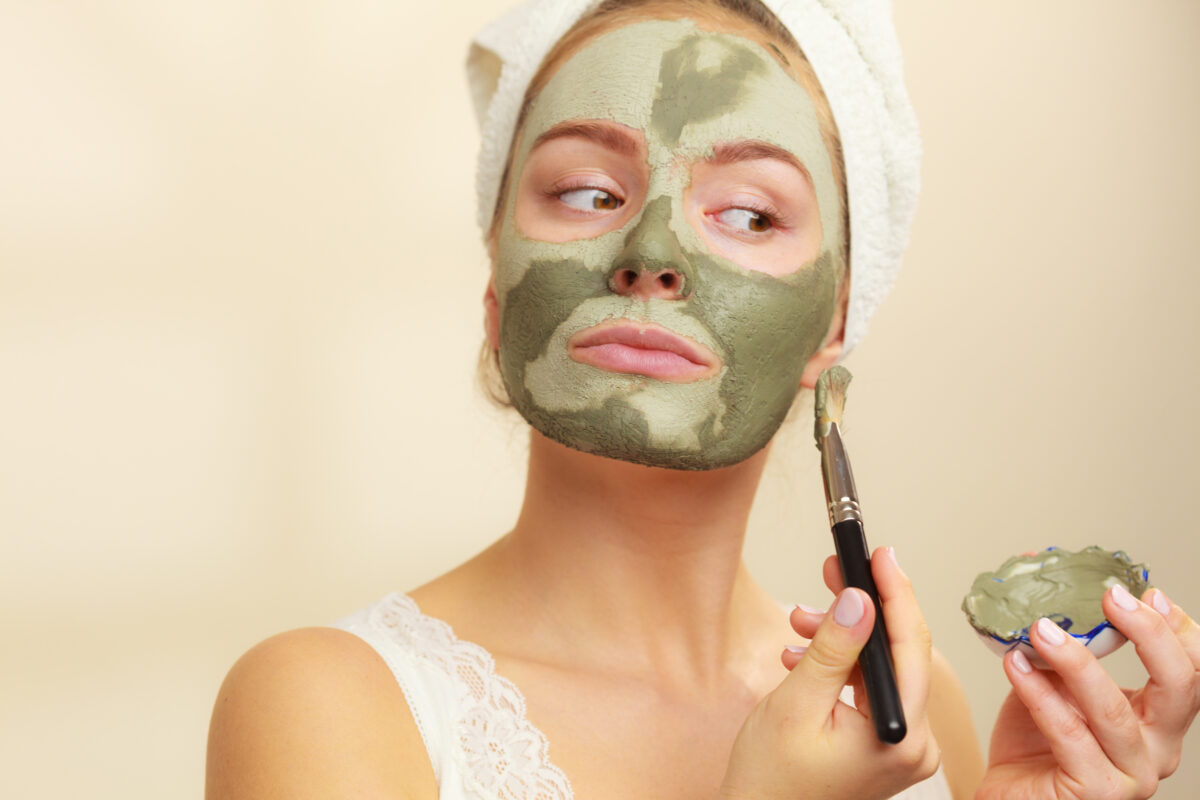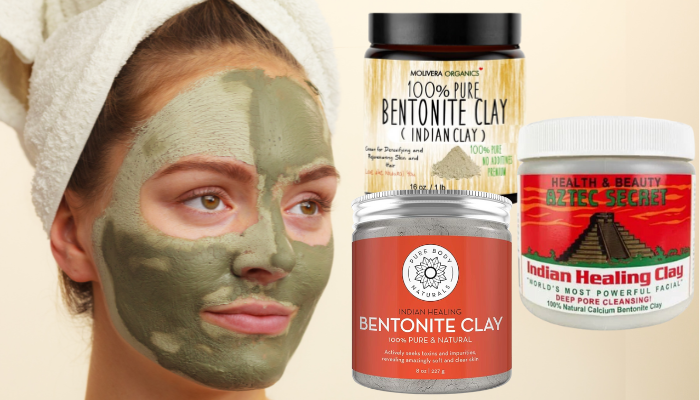If your skin has been feeling greasy, clogged and dull, then you might want to make use of all of the bentonite clay skin benefits. In this article, we’ll explain exactly what bentonite clay is, and how it works. We’ll outline all of the bentonite clay skin benefits as well as its drawbacks, and make sure you know how to use it properly. If you are a fan of crafting your own skin care, we’ve given a wonderful recipe for the perfect bentonite clay mask.
What is bentonite clay and how does it work?
Bentonite clay is an absorbent clay with quite a few skin benefits. It is often taken from volcanic ash.
It’s important to note that there are a few types of clay referred to as bentonite, but most frequently it’s the term used to talk about montmorillonite, or at least about a clay that contains mostly montmorillonite.
Montmorillonite is a mineral, or rather, a group of soft phyllosilicate minerals. These minerals have a soft texture, and they’re fabulous for the crafting of bentonite clay masks that blend with water as well as various ingredients that are beneficial to the skin.
Bentonite Clay Skin Benefits
For most people, bentonite clay skin benefits come when it’s used occasionally as a mask. This clay is extremely absorbent, so it is able to pull oils and impurities from the skin. That is why those with extremely oily skin love it – it’s an instant mattifying treatment!

It also makes it a phenomenal remedy for anyone with blackheads or a lot of sebaceous filaments. However, those with dry skin should definitely avoid bentonite clay masks, as they’ll end up drying their skin.
There are also some benefits to using bentonite clay for acne-prone skin, especially if the acne is caused by excess production of oil. Bentonite clay masks won’t be as useful if the acne is caused by irritation, dehydration, or hormonal imbalance.
The bentonite clay acts as a vacuum, helping to remove the sebum and impurities that clog the pores and cause blackheads, whiteheads and acne. This, in turn, helps to prevent breakouts especially when done multiple times a week.
Are there side effects of bentonite clay masks?
You definitely want to go into using bentonite clay masks informed. Bentonite clay is a fairly safe skin care ingredient, but it is not without its risks.
- Since it’s a clay taken directly from nature, it can hold contaminants. The FDA has had to give out warning letters to cosmetics companies that used bentonite clay that had high levels of lead in it. While this is not all that dangerous when applied topically, since the skin does keep those kinds of bad things out, it’s still important to only purchase bentonite clay products from companies you trust.
- Since bentonite clay is absorbent of both oil and water, it can severely exacerbate both dryness and dehydration in the skin. It’s better to avoid this clay altogether and opt for a gentler clay like kaolin if you do have dry or dehydrated skin. If you are dead set on using it, however, make sure to moisturize very well afterwards, and to choose a bentonite clay mask that also contains a lot of moisturizing ingredients.
- Bentonite clay can also be a little irritating to those with sensitive skin. Make sure to patch test any bentonite clay skin care products you plan on using, to make sure they won’t irritate your skin or turn it red.
- Bentonite clay masks, if improperly formulated, can disrupt the skin’s pH. This can make the skin irritated, more susceptible to acne, and overall just feeling rough and uncomfortable. Make sure to buy bentonite clay products from reputable brands (like the ones I’ve listed), and if you make your own, make sure to follow my recipe, which helps reduce the pH of the clay.
How to Use Bentonite Clay in Skin Care
Bentonite clay is always best to use as a mask! You can make your own mask following the recipe I list below, or use one of the best bentonite clay masks on our list!
This is a routine you should follow once or twice a week at most, and avoid doing it when your skin is feeling dry or dehydrated.
- Cleanse
You’ll want to start by prepping your skin. Cleanse your skin with your cleanser of choice – if you wear makeup, you might want to double cleanse with a makeup remover followed by a traditional cleanser.
- Exfoliate
If you’d like to, you can exfoliate your skin before applying your bentonite mask. Any exfoliant can work, but if you’re looking to deep cleanse your pores, use a chemical exfoliant with at least 2% salicylic acid, and let it sit on your skin for 5-10 minutes.
- Apply the Mask
Apply your bentonite clay mask to your skin in a very thin layer, using upward motions or strokes. You really don’t need to use a lot of the clay mask, and the thinner the layer, the better. You can use a clean foundation brush to get the perfect mask application, although fingers work too.
- Give It Some Time
Let the mask sit on your skin for anywhere between 5-15 minutes. Longer isn’t better with clay masks, so it’s better to start off with only leaving it on for 5 minutes – if you feel like that wasn’t enough, you can add a couple more minutes to the wait time next time you use it.
- Remove It
Once enough time has elapsed, and the mask is dry and tight, you should remove it. The easiest way is using facial sponges or a damp face cloth and gently wiping the face until all traces of the mask are gone. You can also steam your face to break loose the mask, although I don’t like recommending it for people to do at home, since overly hot steam can damage the skin.
- Moisturize
After masking it’s very important to infuse the skin with moisture and hydration! If you have the time, it’d be great to apply a hydrating and nourishing mask to the skin, and letting it sit for 10-20 minutes.
- Nourish Your Skin
If you’ve used a hydrating mask, remove it as required. Otherwise, delve into the rest of your skin care routine, focusing on hydrating ingredients. At the bare minimum apply to your skin a hydrating serum followed by a moisturizer, although it’d be better to apply a hydrating toner, hydrating essence, a serum, and then a moisturizer. If you used the bentonite clay mask in the daytime, finish off with sunscreen.
Make Your Own Bentonite Clay Mask
Bentonite clay on its own can be purchased very cheaply online, so why not experiment with making your own bentonite clay masks? I’ll list a super simple recipe that almost anyone can prepare, and then give you some suggestions for ways to jazz it up!
As always with DIY skin care, it’s better to prepare this bentonite clay mask fresh each time you intend to use it. Skin care products made at home without preservatives will spoil very quickly when compared to commercial products, and spoiled skin care can irritate the skin or infect it with unwanted bacteria. Avoid this problem altogether by preparing just enough for one use.

Please note that some recipes online suggest mixing the clay with water, but this is actually not a great idea. Bentonite clay has a pH between 9.5 and 10.5, which can be extremely irritating to the skin and make it more susceptible to damage. By adding unfiltered apple cider vinegar you reduce the pH of the formula, making it much safer and better for the skin.
For this recipe you will need:
- 100% bentonite clay in the form of a very thin powder – you won’t need more than a teaspoon of it for a single-use mask.
- Unfiltered apple cider vinegar (ideally of the organic variety), to create a creamy texture and to reduce the pH of the mask. Water or other vinegars are not a good substitute!
- A clean ceramic or glass bowl
- A mask brush (or a totally clean flat foundation brush)
- Optional: a couple drops of tea tree or lavender essential oil. You can also add some honey, yogurt, or aloe vera for extra hydration.
In your clean bowl, combine a teaspoon of bentonite clay with an equal amount of apple cider vinegar, and mix with your brush. The blend might foam up a little bit, which is perfectly fine. You can add a few drops of essential oil or a hydrating ingredient as well.
Using the brush apply the bentonite clay mask to cleansed skin in upward motions, following the directions I outlined in the previous section.





